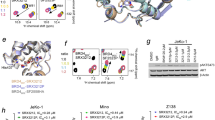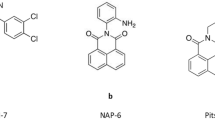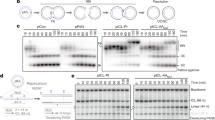Abstract
Reactions of diol epoxide metabolites of carcinogenic poly cyclic aromatic hydrocarbons with DNA are thought to initiate the carcinogenic process1,2. Although formation of a benzo[a]pyrene (BaP) diol epoxide-deoxyguanosine adduct has been held responsible for biological activity3–5, the more potent carcinogen, 7,12-dimethylbenz[a]anthracene (DMBA) binds extensively to deoxyadenosine residues in DNA, suggesting that hydrocarbon carcinogen-deoxyadenosine adducts may be instrumental in tumour initiation6–8. Because the bay region diol epoxides9 of benzo[c]phenanthrene (BcPh) are very active tumour initiators10, and the relative activities of the four configurationally isomeric 3,4-diol 1,2-e pox ides (Fig. 1) are known11, we examined their reactions with DNA. Each BcPh diol epoxide isomer exhibits a remarkable preference for covalent binding to DNA over hydrolysis, each yields a unique distribution of products with the nucleosides of DNA and each reacts extensively with deoxyadenosine residues in DNA. The relative tumour initiating activities of these stereoisomers is best reflected by the relative yields of one of the deoxyadenosine adducts formed.
This is a preview of subscription content, access via your institution
Access options
Subscribe to this journal
Receive 51 print issues and online access
$199.00 per year
only $3.90 per issue
Buy this article
- Purchase on Springer Link
- Instant access to full article PDF
Prices may be subject to local taxes which are calculated during checkout
Similar content being viewed by others
References
1. Sims, P., Grover, P. L., Swaisland, A., Pal, K. & Hewer, A. Nature 252, 326–328 (1974). 2. Buening, M. K. et al. Proc. natn. Acad. Sci. U.S.A. 75, 5358–5361 (1978). 3. Meehan, T., Straub, K. & Calvin, M. Nature 269, 725–727 (1977). 4. Ashurst, S. W. & Cohen, G. M. Chem. Biol. Interact. 29, 117–127 (1980). 5. Lo, K–y & Kakunaga, T. Biochem. biophys. Res. Commun. 99, 820–829 (1981). 6. Dipple, A., Pigott, M. A., Moschel, R. C. & Costantino, A. Cancer Res. 43,4132–4135 (1983). 7. Dipple, A., Sawicki, J. T., Moschel, R. C. & Bigger, C. A. H. in Extrahepatic Drug Metabolism and Chemical Carcinogenesis (eds Rydstrom, J., Montelius, J. & Bengtsson, M.) 439–448 (Elsevier, Amsterdam, 1983). 8. Bigger, C. A. H., Sawicki, J. T., Blake, D. M., Raymond, L. G. & Dipple, A. Cancer Res. 43, 5647–5651 (1983). 9. Jerina, D. M. & Daly, J. W. in Drug Metabolism (eds Parke, D. V. & Smith, R. L.) 13–32 (Taylor & Francis, London, 1976). 10. Levin, W. et al. Cancer Res. 40, 3910–3914 (1980). 11. Levin, W. et al. Cancer Res. 46, 2257–2261 (1986). 12. Jerina, D. M. et al. in Biological Reactive Intermediates III (eds Snyder, R., Kocsis, J. J., Jollow, D. J. & Witmer, C. M.) 11–30 (Plenum, New York, 1986). 13. Moussaoui, K., Geacintov, N. E. & Harvey, R. G. Biophys. Chem. 22, 285–297 (1985). 14. Agarwal, S. K. et al. J. Am. chem. Soc. 109, 2497–2504 (1987). 15. Zacharias, D. E. et al. Carcinogenesis 5, 1421–1430 (1984). 16. Hirshfeld, F. L. /. chem. Soc. 2126–2135 (1963). 17. Zarbl, H., Sukumar, S., Arthur, A. V., Martin–Zanca, D. & Barbacid, M. Nature 315,382–385 (1985). 18. Quintanilla, M., Brown, K., Ramsden, M. & Balamain, A. Nature 322, 78–80 (1986). 19. Dandekar, S., Sukumar, S., Zarbl, H., Young, L. J. T. & Cardiff, R. D. Molec. cell. Biol. 6, 4104–4108 (1986). 20. Vousden, K. H., Bos, J. L., Marshall, C. J. & Phillips, D. H. Proc. natn. Acad. Sci. U.S.A. 83, 1222–1226 (1986).
Author information
Authors and Affiliations
Rights and permissions
About this article
Cite this article
Dipple, A., Pigott, M., Agarwal, S. et al. Optically active benzo[c]phenanthrene diol epoxides bind extensively to adenine in DNA. Nature 327, 535–536 (1987). https://doi.org/10.1038/327535a0
Received:
Accepted:
Issue Date:
DOI: https://doi.org/10.1038/327535a0
This article is cited by
-
The nucleotide excision repair protein XPC is essential for bulky DNA adducts to promote interleukin-6 expression via the activation of p38-SAPK
Oncogene (2016)
-
Ecotoxicity of polycyclic aromatic hydrocarbons, aromatic amines, and nitroarenes through molecular properties
Environmental Chemistry Letters (2012)
Comments
By submitting a comment you agree to abide by our Terms and Community Guidelines. If you find something abusive or that does not comply with our terms or guidelines please flag it as inappropriate.



